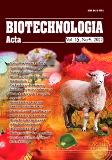ISSN 2410-7751 (Print)
ISSN 2410-776X (Online)

Biotechnologia Acta V. 15, No. 4, 2022
P. 18-21. Bibliography 12, Engl.
UDC: 571.27; 612.017.11; 613.112.3; 616.894-053.8
https://doi.org/10.15407/biotech15.04.018
Nefodova A., Rudyk M., Svyatetska V., Pasichnichenko M.
Taras Shevchenko National University of Kyiv, Kyiv, Ukraine
Aim. The purpose of the study was to evaluate manifestations of systemic inflammation in rats with Alzheimer disease (AD) induced by injections of Aβ1-40 and Aβ25-35 by the assessment of functional polarization of circulating phagocytes.
Methods. AD was induced by intracerebral injections of Aβ1–40 and Aβ25–35 Wistar male rats. Intact and sham-operated animals were used as a control. AD development was affirmed by the assessment of cognitive impairment in behavioral tests (‘Open field’ test, apomorphine test, Barnes maze test), as well as by the level of death of dopaminergic neurons. The functional polarization of circulating phagocytes was designated by phagocytic activity, oxidative metabolism, and the expression of phenotypic markers CD80 and CD206, which were examined by flow cytometry.
Results. Circulating phagocytes from rats with Aβ1-40-induced AD were characterized by increased fraction of phagocytizing monocytes with decreased endocytic activity, moderately up-regulated granulocyte ROS generation along with temperate increase of CD86+ mononuclear phagocyte fraction and high level of CD206 expression. Two widely accepted indices of systemic inflammation: NLR and SII were higher in these animals than those in control rats by 6,5 and 7,5 times respectively. In rats with Aβ25-35-induced disease, significantly increased granulocyte ROS generation was registered. NLR and SII values in these animals were slightly higher than those in control rats.
Conclusion. Therefore, Aβ1-40 AD model reproduces disease-associated systemic inflammation at the greater extent than Aβ25-35-induced pathology, and is more appropriate for the study of inflammation in the disease pathophysiology.
Key words: Alzheimer’s disease, animal models, systemic inflammation, circulating phagocytes.
© Palladin Institute of Biochemistry of the National Academy of Sciences of Ukraine, 2022
References
1. Rather M. A., Khan A., Alshahrani S., Rashid H., Qadri M., Rashid S., Alsaffar R. M., Kamal M. A., Rehman M.U. Inflammation and Alzheimer's Disease: Mechanisms and Therapeutic Implications by Natural Products. Mediators Inflamm. 2021, 31(2021), 9982954. https://doi.org/10.1155/2021/9982954
2. Shi Y., Wei B., Li L., Wang B., Sun M. Th17 cells and inflammation in neurological disorders: Possible mechanisms of action. Front Immunol. 2022, 13, 932152. https://doi.org/10.3389/fimmu.2022.932152
3. Walker K. A., Ficek B. N., Westbrook R. Understanding the Role of Systemic Inflammation in Alzheimer's Disease. ACS Chem Neurosci. 2019,10(8), 3340?3342. https://doi.org/10.1021/acschemneuro.9b00333
4. Xie J., Van Hoecke L., Vandenbroucke R. E. The Impact of Systemic Inflammation on Alzheimer's Disease Pathology. Front Immunol. 2022, 12, 796867. https://doi.org/10.3389/fimmu.2021.796867
5. Herrero-Cervera A., Soehnlein O., Kenne E. Neutrophils in chronic inflammatory diseases. Cell Mol Immunol. 2022, 19, 177–191. https://doi.org/10.1038/s41423-021-00832-3
6. Rabinovici G. D. Late-onset Alzheimer Disease. Continuum (Minneapolis, Minn.). 2019, 25(1), 14–33. https://doi.org/10.1212/CON.0000000000000700
7. Kaushal A., Wani W.Y., Anand R., Gill K.D. Spontaneous and induced nontransgenic animal models of AD: modeling AD using combinatorial approach. Am J Alzheimers Dis Other Demen. 2013, 28(4), 318?326. https://doi.org/10.1177/1533317513488914
8. McLarnon J. G., Ryu J. K. Relevance of abeta1-42 intrahippocampal injection as an animal model of inflamed Alzheimer's disease brain. Curr Alzheimer Res. 2008, 5(5),475?480. https://doi.org/10.2174/156720508785908874
9. Dorhoi A., Du Plessis N. Monocytic Myeloid-Derived Suppressor Cells in Chronic Infections. Front. Immunol. 2018, 8,1895. https://doi.org/10.3389/fimmu.2017.01895
10. Yang W., Tao Y., Wu Y., Zhao X., Ye W., Zhao D., Fu L., Tian C., Yang J., He F., Tang L. Neutrophils promote the development of reparative macrophages mediated by ROS to orchestrate liver repair. Nat Commun. 2019,10(1), 1076. https://doi.org/10.1038/s41467-019-09046-8
11. Lopez-Rodriguez A. B., Hennessy E., Murray C. L., Nazmi A., Delaney H. J., Healy D., Fagan S. G., Rooney M., Stewart E., Lewis A., de Barra N., Scarry P., Riggs-Miller L., Boche D., Cunningham M.O., Cunningham C. Acute systemic inflammation exacerbates neuroinflammation in Alzheimer's disease: IL-1? drives amplified responses in primed astrocytes and neuronal network dysfunction. Alzheimers Dement. 2021, 17(10),1735?1755. https://doi.org/10.1002/alz.12341
12. Oliynyk Zh., Rudyk M., Svyatetska V., Dovbynchuk T., Tolstanova G., Skivka L. Systemic inflammation biomarkers in 6-OHDA- and LPS-induced Parkinson’s disease in rats. Ukr. Biochem. J. 2022, 94(1), 33?43. https://doi.org/10.15407/ubj94.01.033

